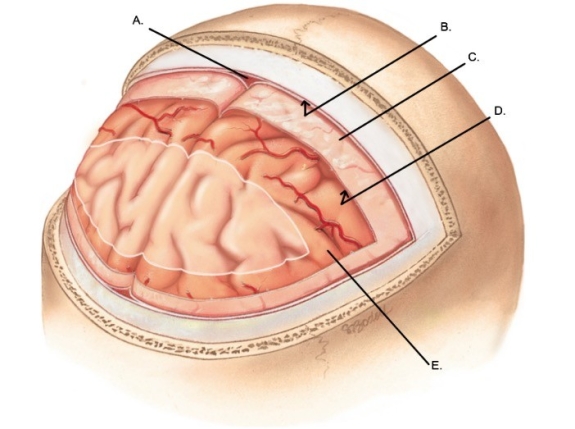A) cause us to stop breathing.
B) affect body temperature regulation.
C) affect pH regulation.
D) prevent puberty.
E) affect sensory projection to the cerebral cortex.
G) C) and E)
Correct Answer

verified
Correct Answer
verified
Multiple Choice
Which ventricle is located between the two halves of the thalamus?
A) First ventricle
B) Second ventricle
C) Third ventricle
D) Fourth ventricle
F) A) and C)
Correct Answer

verified
Correct Answer
verified
Multiple Choice
What are the three major regions of the cerebellum? (Check all that apply.)
A) Flocculonodular lobe
B) Infundibulum
C) Lateral hemispheres
D) Substantia nigra
E) Vermis
G) All of the above
Correct Answer

verified
Correct Answer
verified
Multiple Choice
Dysfunction of the sternocleidomastoid muscle could result from damage to the ________ nerve.
A) vagus
B) abducens
C) accessory
D) hypoglossal
E) facial
G) C) and D)
Correct Answer

verified
Correct Answer
verified
Multiple Choice
The superior colliculi receive input from the
A) eyes, skin, cerebrum, and inferior colliculi.
B) inferior colliculi, pyramids, skin, and red nucleus.
C) skin, ears, pyramids, and cerebellum.
D) cerebrum, cerebellum, thalamus, and inferior colliculi.
E) nose, tongue, and inner ear.
G) B) and D)
Correct Answer

verified
Correct Answer
verified
Multiple Choice
The lateral fissure separates the ________ from the rest of the cerebrum.
A) frontal lobe
B) parietal lobe
C) occipital lobe
D) temporal lobe
E) cerebellum
G) B) and E)
Correct Answer

verified
Correct Answer
verified
Multiple Choice
The blockage of CSF inside the brain is a condition called ________.
A) internal hydrocephalus
B) ventricular hydrocephalus
C) external hydrocephalus
D) internal hematoma
F) A) and B)
Correct Answer

verified
Correct Answer
verified
Multiple Choice
 -This is a lateral view of the brain. What does "C" represent?
-This is a lateral view of the brain. What does "C" represent?
A) Temporal lobe
B) Cerebellum
C) Frontal lobe
D) Occipital lobe
E) Parietal lobe
G) C) and E)
Correct Answer

verified
Correct Answer
verified
Multiple Choice
A person with a lesion in the brain exhibited the following manifestations: normal tension in skeletal muscle, disturbed fine motor control, exhibited tremors when reaching for objects. What part of the brain is most likely damaged?
A) The prefrontal lobe of the cerebrum
B) The frontal lobe of the cerebrum
C) The basal ganglia
D) The pyramids of the medulla oblongata
E) The cerebellum
G) B) and C)
Correct Answer

verified
Correct Answer
verified
Multiple Choice
Which part of the brainstem contains the cardiac center, vasomotor center, and respiratory center?
A) Midbrain
B) Pons
C) Medulla oblongata
D) Cerebellum
F) None of the above
Correct Answer

verified
Correct Answer
verified
Multiple Choice
A physician is evaluating the cranial nerve function of a patient. To evaluate vestibulocochlear nerve function, the physician should
A) stand behind the patient and whisper words to see if the patient can repeat them.
B) ask the patient to follow the movement of an object with her gaze.
C) ask the patient to open her mouth and stick out her tongue.
D) touch the surface of the patient's eyeball to initiate blinking.
F) A) and D)
Correct Answer

verified
Correct Answer
verified
Multiple Choice
Identify the blood vessels that supply blood to the brain. (Check all that apply.)
A) Internal carotid arteries
B) External carotid arteries
C) Vertebral arteries
E) None of the above
Correct Answer

verified
Correct Answer
verified
Multiple Choice
The glossopharyngeal nerve
A) innervates the larynx.
B) is involved in the sense of taste.
C) innervates intrinsic tongue muscles.
D) transmits sensory information from the abdominal viscera.
E) controls facial expressions.
G) A) and C)
Correct Answer

verified
Correct Answer
verified
Multiple Choice
The blink reflex is initiated by contact with the cornea. Which cranial nerve could be assessed by initiating the blink reflex?
A) Trigeminal
B) Oculomotor
C) Optic
D) Olfactory
F) B) and D)
Correct Answer

verified
Correct Answer
verified
Multiple Choice
Which of the following terms does NOT belong with the others?
A) Medulla oblongata
B) Midbrain
C) Pons
D) Thalamus
E) Reticular formation
G) C) and D)
Correct Answer

verified
Correct Answer
verified
Multiple Choice
 -What does "A" represent on the diagram of the skull and brain?
-What does "A" represent on the diagram of the skull and brain?
A) Subarachnoid space
B) Dural venous sinus
C) Pia mater
D) Arachnoid mater
E) Subdural space
G) C) and E)
Correct Answer

verified
Correct Answer
verified
Showing 161 - 176 of 176
Related Exams